Mushrooms and Toadstools: what’s the difference?
The two questions I get asked most often when guiding fungi forages are ‘Is this edible?’ and ‘What’s the difference between mushrooms and toadstools?’ I tend not to answer either directly.
In the case of the former, I encourage the asker to work out for themselves what species they are holding by observing its key features then answer the question for themselves. This may sound evasive, but its much more useful in the long run. The most satisfying foraging moments for any forager comes when they finally ‘crack’ a new species after years of searching and wondering. Its also important that we take personal responsibility for what we put in our mouths. And besides all that…I may not know anyway.
The second question is tricky because I have to second-guess what the asker means by ‘toadstool’. Sometimes they mean ‘any poisonous fungi’, others they mean ‘mushrooms that don’t look like field or cultivated mushrooms’. Occasionally they are wondering about the precise definitions like I am. The dictionary doesn’t help much:
Mushroom: a type of fungus, usually shaped like an umbrella, many of which are edible.
Toadstool: any of several mushroom-like fungus, some of which are poisonous.
Err…thanks…that really helps. The inference is, I suppose, that mushrooms tend to be edible and toadstools tend to be poisonous. This is no use at all for the forager who has to deal in certainties. And besides, I think the cultural distinction in the UK is more subtle.
“Oh, I only pick mushrooms. They are easy, we get them in the horse field. But I wouldn’t know about the toadstools that come up in the woods…”. I hear this sort of thing quite regularly. The inference here is that species that grow in fields (often with white caps and pink to chocolate coloured gills) are safe and edible, but the odd, brightly coloured stuff in the woods may be edible but should be treated with extreme caution. This is muddled thinking that will not only mean you miss out on the best edible species, but may give you a nasty tummy upset, land you in hospital, or worse.
Take a look at these three pictures. One is edible and delicious, one will give you a nasty tummy upset, and one will probably kill you. So which are toadstools and which are mushrooms?
The answer is they are all both and neither…
Left is the yellow stainer, which is unpleasantly poisonous, and virtually indistinguishable from horse and field mushrooms but for the yellow staining that occurs on its base when scuffed.
Centre is a death cap (amanita phalloides) – the one in this picture would be enough to kill you. Read more about Death Caps…
Right is a horse mushroom which is delicious – like an intense version of cultivated mushrooms with aromatic aniseed overtones.
The point here is, if we go around trying to pigeon-hole fungi into arbitary ‘mushroom’/’toadstool’ categories based on some unscientific concept of what ‘looks’ edible, we wont just miss out on the tastiest species, we are in danger of making ourselves seriously ill – or worse.
So here are my 5 steps for distinguishing edible ‘mushrooms’ from inedible ‘toadstools’.
1. Closely observe all the characteristics of the mushroom (colour, size, shape, pores/gills/spines, spore colour, flesh colour, habitat, season, stem colour, ring, volva, root, mycelium, smell, taste, latex, warts, colour change, growth medium) and compare them against at least one quality identification guide until you are 100% sure of the species you have.
2. If not 100% certain, repeat step 1.
3. If not 100% certain, repeat step 1.
4. If not 100% certain, repeat step 1 or throw it away.
5. If it is an edible species, prepare in accordance with guidelines and enjoy.
And remember, any old wive’s tales and rules of thumb you may have heard, such as “if you can peel the cap its safe to eat” etc, are all complete rubbish and likely to land you in hospital or worse. And you would miss out on tasty oddities like these…
Related articles:
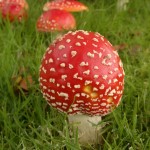
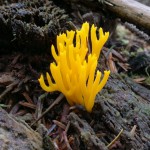

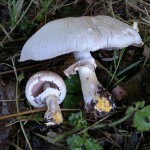
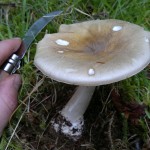

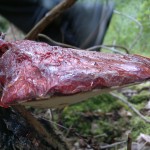
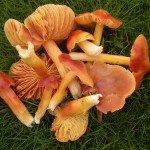
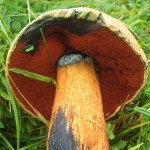
19 Comments
So far your words are the best I have found as a guide for distinguishing between mushrooms you can eat and those you must not, in spite of a disappointing lack of more particular pointers. I suppose, as you say, I shall have to find a qualified guide. Thank you for the helpful pictures.
Thanks John.
Thanks. If you explore this site more widely, you will find a wealth of more specific information! Try looking at the Wild Fungi Guide.
Mark
I was born and hrew up in the Soviet Union. My father, an American, knew about mushrooms not more, than average American, and ive been grateful all my life, that at 6 and later, she rented a tiny room in an old log house “izbah” in a tiny village of 14 loghouses with population of wat widows, living their lives tending to their only cows, or just a goat for milk and butter, and vegeyable and potato patches. Of men there was one veteran amputee and one delayed young man, who lived with his mom, war widow, and was pitied and loved by all, was the village shepherd, took everyones cows and goats to wild fields and medow to graze, returned them at sunset, a happy daily event, bells ringing, cows mooing, smiling women at their open gates welcoming their obedient ” buryonka”, dochka”, “milka” – all “kormilitsas”( “browny”, ” little daughter”, ” lovely” – all ” providers, feeders). In summer months they all housed kids, their grandkids from the city, sent by their working parents to be babysat , for fresh air and natural food. And they were also helpers and mushroom hunters in vast natural forests and groves for miles around. This is where they became experts in the edible and poisonous kind of mushrooms. I pity my fellow Americans not ever experiencing or even suspecting of the mumber of different edible mushrooms. The artificially grown whote shampignons and even runbery brown “baby bella” are a just the poorest in taste of all the wild mushrooms i know.
And yes, getting poisoned by mushrooms ( one – “pale poganka” ) is especially dangerous and real. Ambitious and overly self-assured hunter might get in serious trouble, and die and cause others death. Russians “professional ” mushroom hunters are mostly such children, grown close to nature, mushroom hunting every year, all their life.
Its a pleasure, and a challenge ( hunting is not just a word, though mushrooms dont run). But a talented, knowlegiable, observant hinter will get twice as many , and more valuable ones, than a novice, even if he thinks he’s studied and learnt everything mushrooms.
Exciting, best activity of all, better than fishing and hunting! ( first being static, sedentary, with the same view around; second – plain wrong, unnecessary cruelty, killing).
Ots never late to start – but learn as much as possible, and, when hunting and finding – remember thia article warnings and rules – and be sure to have a caring knowlegiable and experienced local to go through your basket contents – one mushroom at a time. Then – the other expert – that local’s mother or wife will cook’em, having gotten sure in a process of cleaning and sorting – of their safety. And after that enjoy, and learn, whoch ‘breeds’ of mushrooms are good for what – not all for every dish. Some only for pickling – there are two ways of pickling, only one with vinegar among other ingredients. Some for soups, others for sauteeimg with onions, with or without adding sourcream. And the best, spongy under umbrella, especially one sort – ” “beliy” or “borovik” – the king of all mushrooms! – is good to dry, in a great old-fashioned rural “Russian petch”/Russian stove”, or in the regular oven on low with the door open, not cooking, just drying. They can be used to prepare soups – no meat or chisken just mushroom broth! It takes time and skills, and the result…! All champignon growers would become bankrupt if people had known, experienced the many tastes of those mushrooms. But, as the Russian proverb goes ” In case of no fish – crowfish is fish!”
If Russia, Ukraine and their woods are out of question – try Lithuania.
I enjoyed delightful mushroom hunting right minutes from the peaceful resort town of Druskininkai. My friend, a Lithuanian grandmotherof 70, has an apartment in this town and a lovely modern “dacha” – summerhouse just 10 minutes by bus from the town. The village of town residents’ dachas is lovely, safe, with beautiful gardens and little ponds, blooms and blooming vines… She might be willing to have some nice American mushroom hunter as a guest, for a modest fee – she is not rich, a widow, she enjoys this little dacha built by her late husband. Ive known her for 50 years, our husbands were friends. And no, she doesnt run an AirnBnB, this thought came to me as i wrote this.
I hope to make a special trip to Russia next year, if situation clears up, and mushroom hunting is on my list!
egr5458@gmail.com
Thank you so much Eslanda, for this wonderful account of mushroom foraging in the former Soviet Union. Its really interesting. I think the “borovik” you mention may be what we call in the UK penny bun, or cep in France, King Bolete in US, Porcini in Italy…? I discuss it here: . Thanks again for this lovely account. Mark. 🙂
Thanks for your explanation, I live in British Columbia Canada but love your explanation! My wife is a Lake Disrict gal and grew up with a father who rambled the fields and streams of the northwest .
I shaved bright yellow fastballs/mushrooms sprouting all over my lawn are they poisonous please.
Please see here:
Got a garden with lots of ” looking at waxcaps” things.
Would send images but can’t in a comeent so please reply with your email address.
Many Thanks
Dave
I consider ‘toadstools’ to be shelf fungus that grow on trees.
I guess that kind of helps to prove that the term is very loose and subjective. 🙂 (–
I find small white spherical fungi on our bowling green. They are marble sized when I pick them. Are these edible
thanks
Hi,
I’m afraid its not safe, sensible or even possible to help you based on this description. There is information on how to better make your enquiry here: https://gallowaywildfoods.com/help-identifying-wildfood/
Mark.
I was trained as a taxonomic mycologist. I think your article is one of the best written piece I have seen for the general public. I would place a little more stress on volvas and spore prints. But that is only because I think these are very useful to separate out the Aminitas.
I have a notion that toadstools are a reference to “Toads Tools” considering the appearance of some variaties in my locale.
I just completed a mushroom course and was explaining this to my American friend who asked me what about toadstools. I ended up here after googling what toadstools actually mean, as we don’t have that word in Finland. Thank you for a good answer and article. I have learned that in some countries people consider mushrooms to be inedible or even poisonous if they need to be prepared and parboiled before eating, which I find very funny. It’s not like we call potato poisonous even though we prepare it before eating it!
Ha, yes, people are very tense about mushrooms in UK and US especially. I wrote more about this here: The Day I Ate a Deadly Plant: The Spectrum of Edibility
I found a double black fungus in our yard. It was round with a cleft in the middle. It had no stem. What could it be?
So helpful thank you! Honestly was having trouble differentiating between mushroom and toadstool but this was the best yet to really clarify both concepts for me. Hope all is well! Happy thanksgiving and Merry Christmas